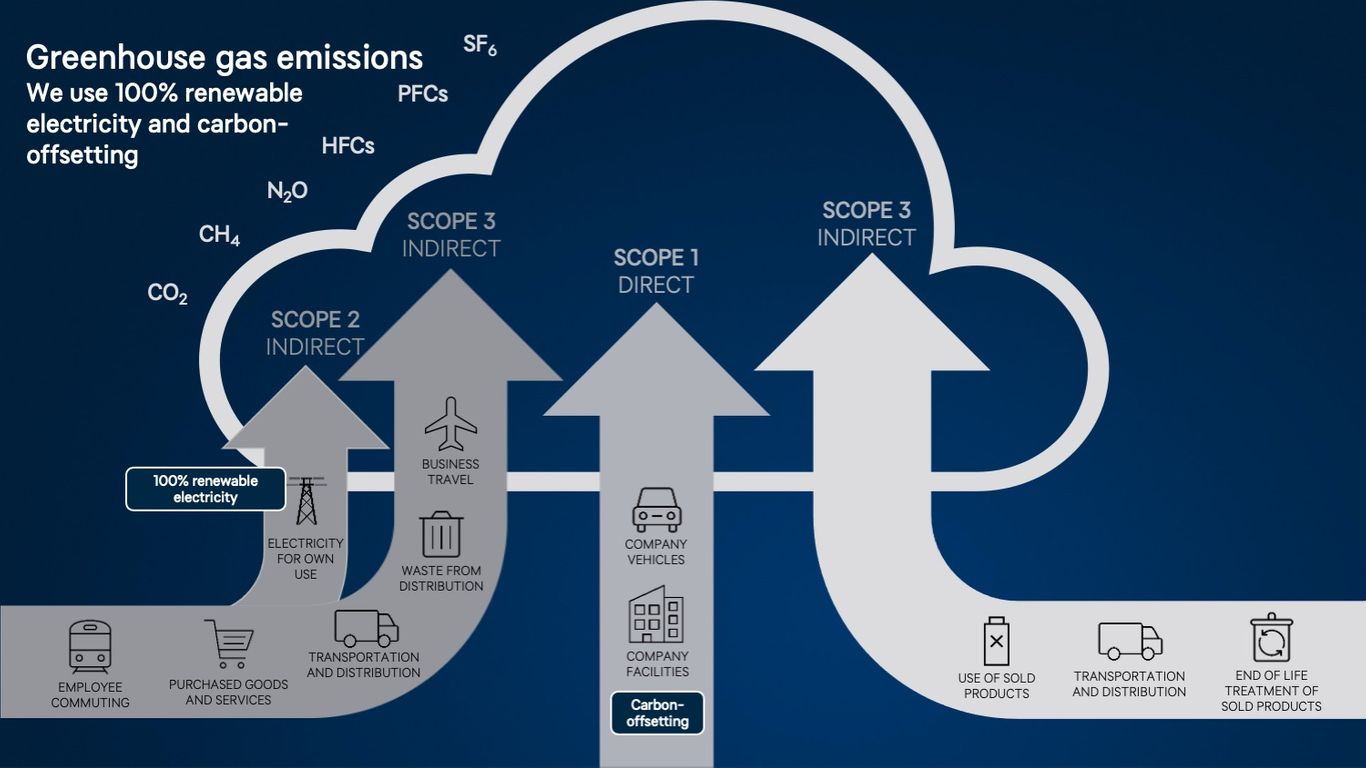
Tele2's climate efforts
Ambitious climate goals, short and long term, towards net-zero
At Tele2, we believe in enabling a society of unlimited possibilities. As part of this mission, we are committed to taking the lead in sustainability and climate action. Addressing climate change is not only a global imperative—it is a business necessity. Our industry has historically contributed to global emissions, and our long-term success depends on actively working to reduce global warming.
We are proud to be leading the way with one of the most ambitious climate targets in our sector: achieving net zero greenhouse gas emissions across our entire value chain by 2035. This commitment is fully aligned with the Paris Agreement’s goal to limit global warming to 1.5°C and has been approved by the Science Based Targets initiative (SBTi), a significant recognition of our efforts.
In 2024, we achieved a 96% reduction in Scope 1 and 2 emissions and a 23% reduction in total value chain emissions since 2019. These milestones mark real progress, and we are building on this momentum as we continue to work towards net zero.
Tele2’s SBTi-approved targets:
Net-zero target
Achieve net-zero GHG emissions in our value chain by 2035 from a 2019 base year.
Near-term targets
Reduce absolute scope 1 and 2 GHG emissions by 100% by 2029 from a 2019 base year.
Reduce scope 3 GHG emissions by 60% per subscription by 2029 from a 2019 base year.
Long-term targets
Maintain 100% absolute scope 1 and 2 GHG emissions reductions from 2029 through 2035.
Reduce absolute scope 3 GHG emissions by 90% by 2035 from a 2019 base year.
Our emission reduction targets have been approved by the Science-Based Targets initiative. This means our targets are consistent with the reductions in GHG emissions required to meet the 2015 Paris Climate Agreement goals. The targets that apply to greenhouse gas emissions from our operations (scopes 1 and 2) are consistent with reductions required to limit global warming to 1.5°C, the most ambitious goal of the Paris Agreement. Our target for emissions from our value chain (scope 3) meets the SBTi’s criteria for ambitious value chain goals and are in line with current best practices.
Scope 1 & 2 emissions (our own operations)
We take our responsibility to reduce emissions seriously, and we are proud to have surpassed our target ahead of schedule. We achieved our Science Based Target of a 90% reduction in Scope 1 and 2 emissions over 2019 levels already in 2022 – three years ahead of the original target of 2025. In 2023 and 2024, the reduction was 96% since 2019.
Since April 2020, 100% of the electricity we purchase has been from renewable sources, with renewables accounting for 98% of our total energy use. This achievement reflects years of commitment. Of our renewable electricity, 55% is sourced through bundled certificates and 45% via unbundled renewable energy purchases.
Further, since October 2020, all newly procured company cars (excluding service vehicles) must be electric. As our existing fleet transitions, this change is expected to deliver a significant drop in Scope 1 emissions.
Planned activities
- Continue to purchase only renewable electricity for our operations.
- Transition all company cars (excluding service vehicles) to electric by 2027.
- Explore ways to reduce emissions from refrigerants and back-up power systems.
- Investigate alternative energy sources for our facilities, such as batteries and hydrogen, to reduce reliance on the grid.
As an initial step within climate change adaptation, we are following trends and alternatives for energy sources needed at our facilities, such as batteries, hydrogen, etc. in order to assess and potentially decrease our dependency on the grid.

Scope 3 emissions (Our value chain)
Our Scope 3 emissions, those from our broader value chain, have been reduced by 12% since 2019, primarily due to lower emissions from capital goods such as network equipment.
These emissions, which make up the vast majority (85%) of our Scope 3 footprint, largely originate from our suppliers. As such, supplier engagement and collaboration are central to achieving our climate goals and reducing the industry’s overall environmental impact.
To drive progress, we’ve introduced regular supplier webinars focused on Scope 3 data collection and its importance. Looking ahead, we have developed a four-step strategy for supplier engagement:
Engage in dialogue with our top suppliers to communicate our targets.
- Encourage suppliers to set their own science-based targets.
- Monitor progress to ensure supplier goals align with our target of a 60% reduction per subscription by 2029.
- Embed emissions reduction requirements into our Business Partner Code of Conduct.
Planned activities
- Work closely with suppliers to align on emission reduction goals and encourage collaborative planning.
- Support our customers in using products in a climate-conscious way, such as through renewable electricity usage.
- Reduce emissions from business travel and commuting through greener transport choices.
SBTi scope 3 target: We are committed to reducing our scope 3 GHG emissions by 60% per subscription by 2029 using 2019 as a base year.
| Emissions by scope 3 category (Tonnes CO2-eq) | Emissions 2024 | Share % 2024 |
|---|---|---|
| Purchased goods and services | 163,856 | 64% |
| Capital goods | 52,901 | 21% |
| Use of sold products | 26,554 | 10% |
| Fuel and energy related activities | 3,173 | 1% |
| Employee commuting | 2,835 | 1% |
| Upstream and downstream transportation and distribution | 3,554 | 1% |
| Business travel | 1,318 | <1% |
| End-of-life treatment of sold products | 31 | <1% |
| Waste generated in operations | 19 | <1% |
| Total | 255,785 | 100 |
External recognition for our climate action
We are far from done, but we will celebrate every victory along the way. Tele2 is ranked as the most sustainable company in Sweden by Time Magazine, and as one of the top Climate Leader 2024 in Europe by the Financial Times. In our annual carbon disclosure to CDP, we were awarded a “A” score for the third year in a row. The “A” score is CDP’s highest management band for companies demonstrating leadership in environmental transparency and performance on climate change. CDP particularly highlights Tele2’s strong performance in target-setting, reduction initiatives, integration of climate issues in business strategy. Tele2 is one of only a small number of almost 24,000 companies to be given CDP’s ‘A’ score.
Science Based Targets initiative (SBTi)
The Science Based Targets initiative (SBTi) is a collaboration between CDP, the United Nations Global Compact, World Resources Institute (WRI) and the World Wide Fund for Nature (WWF). The SBTi defines and promotes best practices in science-based target setting and independently assesses companies’ targets.
Science-based targets are emissions reduction goals in line with what the latest climate science says is needed to meet the goals of the Paris Agreement – limiting global warming to well-below 2°C above pre-industrial levels and pursuing efforts to limit warming to 1.5°C.
The targets also show companies how much and how quickly they need to reduce their greenhouse gas emissions to be consistent with keeping global warming below the most dangerous levels.
The SBTi Net-Zero Standard includes the guidance and criteria companies must reach to achieve science-based net-zero targets consistent with limiting global temperature rise to 1.5 degrees Celsius.
Read more about Science Based Targets initiative here.
Climate related risks and opportunities
Climate risks are integral to Tele2’s Enterprise Risk Management framework and is considered as a strategic risk. Our Board and Executive Management own the monitoring and mitigation of this risk. The framework principles including compliance to our Enterprise Risk Management policies and procedures are applicable to Climate Risks as well. Refer our Risk Management page for a detailed description.
In the Enterprise Risk Management section of our annual report, where we list our most important strategic risks where we describe our climate risk as well and describe it as follows:
The transition to a low carbon economy is associated with transitional risk, e.g. policy, liability or technology risks, that may all incur additional costs. Climate change is increasingly driving regulation and taxation related to reduction of greenhouse gas emissions and the use of fossil fuels. Increasing scarcity of natural resources, particularly rare minerals used in network and consumer technology hardware, may lead to increased hardware costs. Increasing energy costs, Greenhouse Gas (GHG) emissions taxation and price increases caused by natural resource scarcity may incur additional costs.
In its first TCFD report published by Tele2 in 2021, we have listed various scenarios of the climate risk and described our assessment of these scenarios from the perspective of impact and implications of each risk scenario.
The assessment of climate risks showed us that although our climate risk exposure is lower compared to other sectors such as heavy industry, materials and buildings or agriculture, we must work proactively to mitigate the risks associated with climate change. Our work with climate risks is admittedly at the early stages and we acknowledge that we must work to increase the capacity and know-how of how to deal with climate risks and what they entail, dispersing climate change knowledge throughout the organization. What we do know is that the risks associated with climate change will only grow bigger with time, and as such, climate risks are listed as one of the risks in our strategic risk registry. This means that there is a strong effort made by the Group Leadership Team to discuss, evaluate and mitigate the climate risks.
Our key risk mitigation activities are:
- Periodic risk workshops conducted to identify and assess climate risks.
- Tele2 has transitioned to 100% renewable electricity and has certified the Environmental Management System according to ISO 14001.
- We are working to reduce our GHG emissions as quickly as possible to reduce our transitional risk.
- We have transitioned to renewable electricity and are gradually transitioning to renewable energy when feasible.
- Make our networks more energy efficient by continuous implementation of energy efficiency initiatives.
- Continued efforts to reduce e-waste.
- Continued follow-up to ensure compliance with relevant environmental laws and regulations.
As an initial step within climate change adaptation we are following trends and alternatives for energy at our facilities, such as batteries, hydrogen, etc. in order to assess and potentially decrease dependency of the grid.
Tele2 welcomes well-aimed and proportional regulation to mitigate climate change, and believes that the transition to a low carbon economy is an opportunity for innovation and increased business value. With the ambition to lead in sustainability, we are also committed to respond appropriately in cases where the position on climate change of our membership associations is significantly weaker than Tele2’s position or contradicts our climate change efforts.
A detailed description of the climate risk management can be read in the TCFD report.
Climate strategy and transition plan
We have come a long way in reducing our climate impact, but we still have a long way to go before we are satisfied. By following science-based targets our goal is to achieve science-based net-zero emissions as one of the first telcos in the world. To mitigate these risks and to capture these opportunities we have developed a climate strategy and roadmap with clearly defined actions and goals to strive towards.
Follow the link to read about our climate strategy in more detail.